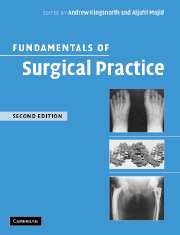Book contents
- Frontmatter
- Contents
- Preface
- Contributors
- 1 Preoperative management
- 2 Principles of anaesthesia
- 3 Postoperative management
- 4 Nutritional support
- 5 Surgical sepsis: prevention and therapy
- 6 Surgical techniques and technology
- 7 Trauma: general principles of management
- 8 Intensive care
- 9 Principles of cancer management
- 10 Ethics, legal aspects and assessment of effectiveness
- 11 Haemopoietic and lymphoreticular systems: anatomy, physiology and pathology
- 12 Upper gastrointestinal surgery
- 13 Lower gastrointestinal surgery
- 14 Hernia management
- 15 Vascular surgery
- 16 Endocrine surgery
- 17 The breast
- 18 Thoracic surgery
- 19 Genitourinary system
- 20 Head and neck
- 21 The central nervous system
- 22 Musculoskeletal system
- 23 Paediatric surgery
- Index
22 - Musculoskeletal system
Published online by Cambridge University Press: 15 December 2009
- Frontmatter
- Contents
- Preface
- Contributors
- 1 Preoperative management
- 2 Principles of anaesthesia
- 3 Postoperative management
- 4 Nutritional support
- 5 Surgical sepsis: prevention and therapy
- 6 Surgical techniques and technology
- 7 Trauma: general principles of management
- 8 Intensive care
- 9 Principles of cancer management
- 10 Ethics, legal aspects and assessment of effectiveness
- 11 Haemopoietic and lymphoreticular systems: anatomy, physiology and pathology
- 12 Upper gastrointestinal surgery
- 13 Lower gastrointestinal surgery
- 14 Hernia management
- 15 Vascular surgery
- 16 Endocrine surgery
- 17 The breast
- 18 Thoracic surgery
- 19 Genitourinary system
- 20 Head and neck
- 21 The central nervous system
- 22 Musculoskeletal system
- 23 Paediatric surgery
- Index
Summary
This chapter describes common orthopaedic conditions with heavy emphasis on the relevant clinical details that should be elucidated on history and examination. With a firm grasp of the principles of clinical orthopaedic assessment, a differential diagnosis can be formulated and appropriate investigations performed subsequently.
FRACTURES
Fractures can be divided into the following types:
Green stick fractures: These occur in children. One cortex is splinted and the other is intact.
Closed fractures: There is no communication between the fracture haematoma and the environment outside the integument. The skin and soft-tissue envelope remain intact.
Open (‘compound’) fractures: There is breach of the integument and soft-tissue envelope surrounding the fracture such that the fracture haematoma communicates with the outside environment. These fractures are associated with an open wound and there is increased risk of deep infection, which may have catastrophic consequences for the healing of bone and soft tissues and subsequent usage of the affected part. Therefore, such fractures invariably require surgical treatment and constitute an orthopaedic emergency. Compound fractures may also be associated with delayed union.
Pathological fractures: These occur in bone weakened by a pre-existing disease, for example metastatic deposits or a generalized bone disease such as osteoporosis. Therefore, the resultant force required to fracture the bone is less than that required to fracture normal bone.
[…]
- Type
- Chapter
- Information
- Fundamentals of Surgical Practice , pp. 440 - 492Publisher: Cambridge University PressPrint publication year: 2006



